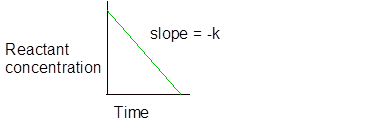
EBK GENERAL CHEMISTRY
11th Edition
ISBN: 8220103631259
Author: Bissonnette
Publisher: YUZU
expand_more
expand_more
format_list_bulleted
Question
Chapter 20, Problem 30E
Interpretation Introduction
Interpretation:
The approximate initial rate for the second order reaction is to be determined.
| Set I | Set II | Set III | |||
| Time, s | [A], M | Time, s | [A], M | Time, s | [A], M |
| 0 | 1.00 | 0 | 1.00 | 0 | 1.00 |
| 25 | 0.78 | 25 | 0.75 | 25 | 0.80 |
| 50 | 0.61 | 50 | 0.50 | 50 | 0.67 |
| 75 | 0.47 | 75 | 0.25 | 75 | 0.57 |
| 100 | 0.37 | 100 | 0.00 | 100 | 0.50 |
| 150 | 0.22 | 150 | 0.40 | ||
| 200 | 0.14 | 200 | 0.33 | ||
| 250 | 0.08 | 250 | 0.29 |
Concept introduction:
- Zero-order reaction- for this,
rate of reaction is independent of the concentration.
And the graph of zero order reaction is-

- The first order reaction is the one in which the rate is directly proportional to the concentration of one of the reactant.
And half-life is
Integral rate law for first order reaction is −
and

- The second order reaction is the one in which the rate is directly proportional to the square of the concentration of one of the reactant.
Integral rate law for second order reaction is −
And the graph of second order reaction is-

Expert Solution & Answer
Want to see the full answer?
Check out a sample textbook solution
Students have asked these similar questions
2. Draw mechanisms for the following reactions.
mg
Et
CO₂Hot
H30t
Et
0
Please correct answer and don't use hand rating
Convert the following structures into a chair representation. Then conduct a chair flip.
Cl
a.
b.
C\....
о
Chapter 20 Solutions
EBK GENERAL CHEMISTRY
Ch. 20 - In the reaction 2A+BC+3D , reactant A is found to...Ch. 20 - From Figure 20-2 estimate the rate of reaction at...Ch. 20 - In the reaction A products, [A] is found to be...Ch. 20 - In the reaction A products, at t = 0. [A]= 0.1565...Ch. 20 - In the reaction A products. 4.40 min after the...Ch. 20 - Refer to Experiment 2 of Table 20.3 and to...Ch. 20 - For the reaction A+2BC ,the rate of reaction is...Ch. 20 - If the rate of reaction (20.3) is 5.7104 M s-1 ,...Ch. 20 - In the reaction A(g)B(g)+C(g) , the totalpressure...Ch. 20 - At 65C , the half-life for the first-order...
Ch. 20 - The initial rate of the reaction A+BC+D is...Ch. 20 - For the reaction A+BC+D , the following initial...Ch. 20 - Prob. 13ECh. 20 - The following data are obtained for the initial...Ch. 20 - One of the following statements is true and the...Ch. 20 - One of the following statements true and the other...Ch. 20 - The first-order reaction A products has t1/2=180...Ch. 20 - The reaction A products is first order in A....Ch. 20 - The reaction A products is first order A. a. If...Ch. 20 - In the first-order reaction A products, [A] =...Ch. 20 - In the first-order reaction A products, it found...Ch. 20 - The half-life of me radioactive isotope...Ch. 20 - Acetoacetic acid, CH2COOH2COOH , a reagent in...Ch. 20 - The following first-order reaction occurs in...Ch. 20 - For the reaction A- products, the following data...Ch. 20 - The decomposition of dimethyl ether at 504C is (...Ch. 20 - [Hint: There are several of arrivivg at answer for...Ch. 20 - [Hint: There are several of arrivivg at answer for...Ch. 20 - Prob. 29ECh. 20 - Prob. 30ECh. 20 - Prob. 31ECh. 20 - Prob. 32ECh. 20 - [Hint: There are several of arrivivg at answer for...Ch. 20 - [Hint: There are several ways of arrivivig at...Ch. 20 - Prob. 35ECh. 20 - Prob. 36ECh. 20 - For the reaction A products, the following data...Ch. 20 - Prob. 38ECh. 20 - For the reaction A products, the data tabulated...Ch. 20 - For the reaction A2B+C , the following data are...Ch. 20 - In three different experiments, the following...Ch. 20 - Ammonia decomposes on the surface of a hot...Ch. 20 - Prob. 43ECh. 20 - Consider three hypothetical reactions A — products...Ch. 20 - Prob. 45ECh. 20 - If even tiny sped is introduced into a mixture of...Ch. 20 - For me reversible reaction A+BC+D , the enthalpy...Ch. 20 - Prob. 48ECh. 20 - By inspection of the reaction profile for the...Ch. 20 - By inspection of the reaction profile for the...Ch. 20 - The rate constant for the reaction...Ch. 20 - At what temperature will the rate constant for the...Ch. 20 - Prob. 53ECh. 20 - The reaction C2H5+OHC2H5OH+I was studied in an...Ch. 20 - The first-order reaction A products has a...Ch. 20 - For the first-order reaction N2O4(g)2NO2+12O2g...Ch. 20 - Prob. 57ECh. 20 - Concerning the rule of thumb stated r Exercise 57,...Ch. 20 - The following statements about catalysis are not...Ch. 20 - Prob. 60ECh. 20 - What are the similarities and differences between...Ch. 20 - Certain gas-phase reactions on a heterogeneous...Ch. 20 - The graph show s the effect of enzyme...Ch. 20 - The graph shows the effect of temperature on...Ch. 20 - Prob. 65ECh. 20 - Prob. 66ECh. 20 - The reaction 2NO+2H2N2+2H2O is second order m [NO]...Ch. 20 - The mechanism proposed for me reaction of H2(g)...Ch. 20 - The reaction 2NO+Cl22NOCl has rate law: rate of...Ch. 20 - A simplified rate law 1o the reaction 2O2(g)3O2(g)...Ch. 20 - Prob. 71ECh. 20 - One proposed meachanism for the condensation of...Ch. 20 - Suppose that the reaction r Example 20-8 is first...Ch. 20 - [A]t as a function of time for the reaction A —...Ch. 20 - Exactly 300 s after decomposition of H2O2(aq)...Ch. 20 - Use the method of Exercise 75 to determine the...Ch. 20 - Prob. 77IAECh. 20 - Prob. 78IAECh. 20 - Hydroxide ion is involved in the mechanism of the...Ch. 20 - The half-life for the first-order decomposition of...Ch. 20 - The decomposition of ethylene oxide at 690 K is...Ch. 20 - Prob. 82IAECh. 20 - The following data are for the reaction 2 A + B ...Ch. 20 - Prob. 84IAECh. 20 - Prob. 85IAECh. 20 - Prob. 86IAECh. 20 - The following three-step mechanism has been...Ch. 20 - Prob. 88IAECh. 20 - Prob. 89IAECh. 20 - Prob. 90IAECh. 20 - Prob. 91IAECh. 20 - Prob. 92IAECh. 20 - Prob. 93IAECh. 20 - You want to test the following proposed mechanism...Ch. 20 - Prob. 95IAECh. 20 - Benzenediazonium chloride decomposes by a...Ch. 20 - The object is to study the kinetics of the...Ch. 20 - Prob. 98SAECh. 20 - Prob. 99SAECh. 20 - Explain the important distinctions between each...Ch. 20 - Prob. 101SAECh. 20 - A first-order reaction A — products, has a...Ch. 20 - Prob. 103SAECh. 20 - Prob. 104SAECh. 20 - The rate of a chemical reaction generally...Ch. 20 - For the reaction A+B2C, which proceeds by a...Ch. 20 - Prob. 107SAECh. 20 - Prob. 108SAECh. 20 - Prob. 109SAECh. 20 - For me reaction A products the following data are...Ch. 20 - For the reaction A+2BC+D , the rate law is rate...Ch. 20 - Prob. 112SAECh. 20 - If the plot of the reactant concentration versus...Ch. 20 - Prob. 114SAECh. 20 - Prob. 115SAE
Knowledge Booster
Similar questions
- Aktiv Learning App Cengage Digital Learning Part of Speech Table for Assign x o Mail-Karen Ento-Outlook * + app.aktiv.com Your Aktiv Learning trial expires on 02/06/25 at 01:15 PM Curved arrows are used to illustrate the flow of electrons. Using the provided starting and product structures, draw the curved electron-pushing arrows for the following reaction or mechanistic step(s). Be sure to account for all bond-breaking and bond-making steps. Problem 17 of 30 Drawing Arrows heat 4 O M B D 5x H H Und Settings H Done :0: H Jararrow_forwardConvert the following chairs into ring representations: a. Brz b.arrow_forwardDrawing Arrows 1 I I 1 heat 1 51 MO + Drag To Und Settings Done 0 0 Jan 31 3:5arrow_forward
- Don't used hand raitingarrow_forwardGramicidin A can adopt more than one structure; NMR spectroscopy has revealed an “end-to-end” dimer form, and x-ray crystallography has revealed an “anti-parallel double- helical” form. Briefly outline and describe an experimentalapproach/strategy to investigate WHICH configuration (“end-to-end dimer” vs “anti-paralleldouble helical”) gramicidin adopts in an actual lipid bilayer.arrow_forwardDon't used hand raitingarrow_forward
- CHEM2323 Problem 2-24 Tt O e: ל Predict the product(s) of the following acid/base reactions. Draw curved arrows to show the formation and breaking of bonds. If the bonds needed are not drawn out, you should redraw them. + BF3 (a) (b) HI + (c) OH -BF Problem 2-25 Use curved arrows and a proton (H+) to draw the protonated form of the following Lewis bases. Before starting, add all missing lone pairs. (a) (b) :0: (c) N 1 CHEM2323 PS CH02 Name:arrow_forwardCHEM2323 Problem 2-26 Tt O PS CH02 Name: Use the curved-arrow formalism to show how the electrons flow in the resonance form on the left to give the one on the right. (Draw all lone pairs first) (a) NH2 NH2 + (b) Problem 2-27 Double bonds can also act like Lewis bases, sharing their electrons with Lewis acids. Use curved arrows to show how each of the following double bonds will react with H-Cl and draw the resulting carbocation. (a) H2C=CH2 (b) (c) Problem 2-28 Identify the most electronegative element in each of the following molecules: (a) CH2FCI F Problem 2-29 (b) FCH2CH2CH2Br (c) HOCH2CH2NH2 (d) CH3OCH2Li F 0 0 Use the electronegativity table in Figure 2.3 to predict which bond in the following pairs is more polar and indicate the direction of bond polarity for each compound. (a) H3C-Cl or Cl-CI (b) H3C-H or H-CI (c) HO-CH3 or (CH3)3Si-CH3 (d) H3C-Li or Li-OHarrow_forwardDon't used hand raitingarrow_forward
arrow_back_ios
SEE MORE QUESTIONS
arrow_forward_ios
Recommended textbooks for you
 Chemistry: Principles and ReactionsChemistryISBN:9781305079373Author:William L. Masterton, Cecile N. HurleyPublisher:Cengage Learning
Chemistry: Principles and ReactionsChemistryISBN:9781305079373Author:William L. Masterton, Cecile N. HurleyPublisher:Cengage Learning Physical ChemistryChemistryISBN:9781133958437Author:Ball, David W. (david Warren), BAER, TomasPublisher:Wadsworth Cengage Learning,
Physical ChemistryChemistryISBN:9781133958437Author:Ball, David W. (david Warren), BAER, TomasPublisher:Wadsworth Cengage Learning, Principles of Modern ChemistryChemistryISBN:9781305079113Author:David W. Oxtoby, H. Pat Gillis, Laurie J. ButlerPublisher:Cengage Learning
Principles of Modern ChemistryChemistryISBN:9781305079113Author:David W. Oxtoby, H. Pat Gillis, Laurie J. ButlerPublisher:Cengage Learning Chemistry: Principles and PracticeChemistryISBN:9780534420123Author:Daniel L. Reger, Scott R. Goode, David W. Ball, Edward MercerPublisher:Cengage Learning
Chemistry: Principles and PracticeChemistryISBN:9780534420123Author:Daniel L. Reger, Scott R. Goode, David W. Ball, Edward MercerPublisher:Cengage Learning Chemistry & Chemical ReactivityChemistryISBN:9781337399074Author:John C. Kotz, Paul M. Treichel, John Townsend, David TreichelPublisher:Cengage Learning
Chemistry & Chemical ReactivityChemistryISBN:9781337399074Author:John C. Kotz, Paul M. Treichel, John Townsend, David TreichelPublisher:Cengage Learning Chemistry: The Molecular ScienceChemistryISBN:9781285199047Author:John W. Moore, Conrad L. StanitskiPublisher:Cengage Learning
Chemistry: The Molecular ScienceChemistryISBN:9781285199047Author:John W. Moore, Conrad L. StanitskiPublisher:Cengage Learning

Chemistry: Principles and Reactions
Chemistry
ISBN:9781305079373
Author:William L. Masterton, Cecile N. Hurley
Publisher:Cengage Learning

Physical Chemistry
Chemistry
ISBN:9781133958437
Author:Ball, David W. (david Warren), BAER, Tomas
Publisher:Wadsworth Cengage Learning,

Principles of Modern Chemistry
Chemistry
ISBN:9781305079113
Author:David W. Oxtoby, H. Pat Gillis, Laurie J. Butler
Publisher:Cengage Learning

Chemistry: Principles and Practice
Chemistry
ISBN:9780534420123
Author:Daniel L. Reger, Scott R. Goode, David W. Ball, Edward Mercer
Publisher:Cengage Learning

Chemistry & Chemical Reactivity
Chemistry
ISBN:9781337399074
Author:John C. Kotz, Paul M. Treichel, John Townsend, David Treichel
Publisher:Cengage Learning

Chemistry: The Molecular Science
Chemistry
ISBN:9781285199047
Author:John W. Moore, Conrad L. Stanitski
Publisher:Cengage Learning